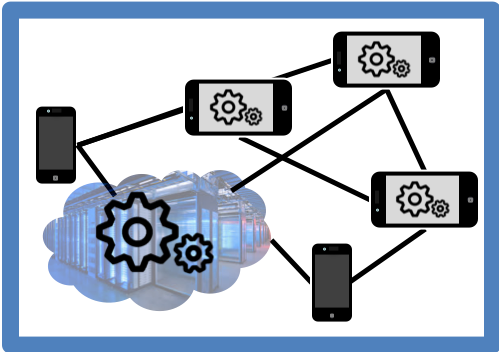LI

NS
research
group
Learning, Incentives, and Optimization
for Networked Systems
The emergence of edge and fog computing allows an ever-larger array of devices, ranging from cloud servers to smartphones to low-power sensors, to support new services like smart cities, generative AI (artificial intelligence), and mixed reality. These applications and services increasingly require seamless cooperation between data, network and computing resources contributed from multiple devices in order to function effectively and scale to billions of users.
Our research uses learning, incentives, and optimization to bridge two fundamental constraints on device cooperation in networked systems: (i) devices' willingness to work together, e.g., if devices have different owners; and (ii) their ability to work together, due to limited data, network, or computing resources. We design, build, and analyze markets for network and compute resources, distributed learning algorithms designed to run on networked devices, and prediction algorithms and models for data with networked structure.
Network and Computing Marketplaces

The proliferation of IoT and machine learning applications has substantially increased utilization of network and computing resources, leading to increased operating costs that may not be economically sustainable. Our work on smart data pricing (SDP) develops economic theories of the markets for data and computing resources that underlie the success of the Internet, and the mechanisms that govern applications' competition for device resources. Such markets aim to efficiently allocate resources to devices according to their heterogeneous, and potentially dynamic, needs. A common challenge is the dynamics of user demands over time, which often leads to dynamic pricing mechanisms in which users can pay for dynamic amounts of resources that match their demands at different times.
Planning for uncertainty
- Bandits for resource allocation (INFOCOM 2023, MobiHoc 2022, HotMobile 2022, TMC 2022 (extended from ICNP 2019), CISS 2021, AAAI 2020)
- Optimizing for mobility (JSAC 2023 (extended from INFOCOM 2022))
- Shared data plans (ToN 2018 (extended from INFOCOM 2015), INFOCOM 2018, JSAC 2017)
Provider aggregation
- Distributing Computation (MLSys 2023, ICDCS 2020, ToN 2017 (extended from ICDCS 2015))
- Network aggregation (ToN 2020 (extended from INFOCOM 2017), ITC 31)
- Cloud aggregation (SoCC 2021, SIGMETRICS 2016)
Dynamic pricing mechanisms
- Mobile data pricing (JSAC 2019, INFOCOM 2018, DataMi)
- Dynamic cloud pricing (ToN 2020 (extended from INFOCOM 2019), INFOCOM 2018, INFOCOM 2017, SIGCOMM 2015)
- Scheduling wireless access (JSAC 2019, MobiSys 2019)
Networked Learning

Many emerging applications that utilize edge and fog computing are based on machine learning and artificial intelligence, which have achieved remarkable success in a range of areas like vision, gaming, and autonomous vehicles. Running such machine learning algorithms in practice, however, requires considering how heterogeneous devices may contribute to such algorithms, accounting for the data they collect, the local computations they run, and the updates that they make to common models or inferences. Our work designs and analyzes new machine learning algorithms that both incentivize devices to make more useful contributions and optimally leverage these contributions in training or making inferences from learning models.
Learning with limited resources
- ML on volatile instances (IWQoS 2023, MAMA 2022, ToN 2021 (extended from INFOCOM 2020)), AISTATS 2021, INFOCOM 2020, DeepMarket (ICDCS 2020 demo, SIGCOMM 2019 demo))
- Accelerating inference in edge computing (INFOCOM 2020)
Collaborative machine learning
- Learning shared models (AISTATS 2022, AAAI 2022)
- Optimizing federated learning contributions (WiOpt 2021, ToN 2021 (extended from INFOCOM 2020))
- Collaboration and resilience (AISTATS 2023, ToSN 2021 (extended from IPSN 2020))
Networked Data

The pervasiveness of Internet-connected devices in the Internet-of-Things allows these devices and their human owners to cooperate with each other by forming spatial and social relationships respectively in physical (e.g., smart cities) and virtual (e.g., online social networks) communities. Our work models these relationships to predict future user and device interactions from historical data and design mechanisms for devices to run these applications. Predicting and incentivizing user interactions in such settings is particularly difficult since there are large numbers of users present with dynamic and heterogeneous spatial and social relationships. For example, vehicles can move towards many different locations in a city, and each direction of movement will have a different impact on road congestion and other vehicles' chosen movements. Our ongoing work uses machine learning approaches to handle these complexities.
Incentivizing spatial mobility
- IoT data collection (SECON 2021, IoTJ 2020, TMC 2019, INFOCOM 2019)
- Pricing and resource provisioning (ACM E-Energy 2023, INFOCOM 2020)
- Optimal taxi movement (INFOCOM 2018, NeurIPS MLITS Workshop 2017)
Characterizing virtual communities
- Exploiting network structure (IoTDI 2023, NeurIPS 2022, CIKM 2022)
- Influence maximization (AISTATS 2022)
- Dynamic graph predictions (AAAI 2021, ICDM 2021)